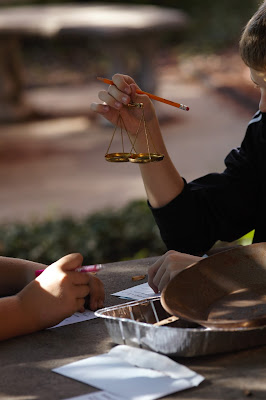If this is your first stop on this blog... I am a HUGE believer in the power of professional development and developing a professional learning network.
Awesome strategies, cool classroom ideas, growing in content knowledge as well as gaining new and useful techniques. Always moving, changing, adding to lessons in order to make good things in your classroom become great.
All can be found through networking with other teachers.
Just like my new favorite historical thinking tool. It's called the Evidence Analysis Window Frame, and it is awesome. It's just a little plastic with some historical thinking questions, but it helped turn a lesson that I have done for 9 years...and done well, into a great lesson. With much less work required by me!
I tried them out for the first time while analyzing the American Progress painting by John Gast. I have had my students analyze this painting every single year I have taught. I have always felt like it was done well and students always seemed engaged and involved in the conversation.
This took it to a whole new level.
I printed off 12 color copies of the painting on 8x10 paper.
I split my class into two groups, one group went out into our large open space to work on another assignment, while I spent time with the other analyzing the painting. This allowed me to focus on a small group of students at a time as well as accomplish multiple things in class that day.
I passed out the plastic covers and some small dry erase markers to the class. We reviewed what historians do with a source as soon as they get it. Source it.
These awesome overlays have the basic sourcing questions on the left side of the window. I can have the students either circle where they find the answer on the painting or write the answer under the question. Totally depended on the question and type of document. Since this was a painting/image I had the students do a lot of marking up on the actual document itself.
Then we moved to the contextualization and corroboration side of the window. I love it! The work was done for me. I had the questions to go off of and they had to locate the answers, or proof of their answers on the document. SO MUCH LESS WORK THAN I DID BEFORE!
So...what were the results?
You can already guess what my thoughts were on the activity for the day. Less work for me, engaging for the students, at least the same or even better understanding of the document than the previous lesson I had used. Win. Win. WIN!
What about the students? I told them I was writing a blog post on these overlays and the lesson for the day, and asked them what they thought. Here are just a few of the responses.
"This was awesome. I loved the way we could actually write on the picture."
"I could see everything much clearer than before."
"This was interactive. I totally understand Manifest Destiny better now."
"It was fun!"These will be used throughout my class on a pretty regular basis. I can do a whole-class activity or small group or even use it as a station activity when I'm trying to incorporate many different concepts in one class period.
Ok...real deal now. What about cost. How much are these babies and how can I convince my district to get them for me? Here's the deal. You can get a set of 5 of these for less than 10$. That's pretty good! Order 25 and it's less than 40$. I'm not sure what your school's financial state is and how willing the district is to help purchase items for the classroom. But I will say, these are incredibly useful and worth the money. PLUS...double bonus. I if you're doing any kind of cross-curricular work with the language arts department, these can totally be used in that class as well! I already gave one to our 8th grade language arts teacher!
Click here for the website to order. This link will take you to the secondary version, there is also an elementary one if you click here.













